|
Fiat CEO Sergio
Marchione has revealed that the Italian carmaker is to
revive the spirit of the famous Fiat Campagnola jeep and
head cross country once more, as it is planning to develop
its own branded version of the Iveco Massif. The Massif is
the fruit of a new industrial collaboration between Fiat
Group-owned Iveco and Spanish off-road vehicle manufacturer
Santana Motor. Eight years ago Santana reengineered its
PS-10 Anibal off-roader - which can trace its lineage right
back to the Land Rover - to accept an Iveco-sourced
3.0-litre diesel powerplant and from this was developed an
agreement which will see Iveco selling a rebadged version
from this year through its global distribution network.
Iveco see the Massif as a logical extension to their
burgeoning product range, providing a ready-made solution
that they have been able to realise in a very short space of
time since a formal letter of intent was signed late last
May with Santana.
However, late
last week Sergio Marchionne revealed that Fiat is also
planning to introduce its own version of the Iveco
Massif/Santana PS-10 Anibal theme. "We are working on the
opportunity to develop to a version of the Massif
cross-country vehicle for Fiat, using the same motors and
transmissions but obviously with a different body and
interior," he told journalists. While the Iveco Massif is
virtually unchanged in finish from the Santana Anibal, it is
simply rebadged, Marchionne suggests that a Fiat version
will be much more refined with a more-modern interior and
restyled exterior, as Fiat Group Automobiles revives a
cross-country tradition that - with the two versions of the
Campagnola - lasted for thirty five years until the
mid-1980s.
The PS-10 Anibal
traces its lineage right back to the Land Rover, a vehicle
which is still in production in Defender guise and sold
globally both as an all-terrain workhorse, and in more
recent years, as a lifestyle vehicle. While Fiat's previous
senior management missed the rise in fashion of the
four-wheel-driver off-road segment, a catch-up game has seen
the Italian carmaker creating an alliance with Suzuki to tap
into the Japanese firm's vast experience in building small
off-road vehicles to help catapult itself into contention.
The Fiat Sedici (a reworked Suzuki SX4) has far exceeded
initial expectations in the year it has been on sale in
Europe and production volumes are now set to being pushed
well above projected targets.
Santana Motors
can also boast vast experience building off road vehicles,
and the Spanish automotive firm's decision to use
Iveco-sourced powertrains in its main-selling vehicle gives
Fiat an ideal chance to leverage this position to its
advantage. The origins of the Santana company can be traced
back to the formation of Metalurgica de Santa Ana, S.A. in
Linares, Spain in 1955. The company started out by building
agricultural machinery and gearboxes. Their new factory had
been built with the aid of funding from the Spanish
government, and with their help, the following year an
agreement was reached with Rover to build the Land Rover at
the plant. Santana enjoyed a long association with Land
Rover having built in the region of 300,000 'Series'
vehicles from 1958 through to 1985. By the end of this
period however, the vehicles being built were quite
different in many respects from Land Rovers, and in 1983 all
links with Land Rover ceased. Nevertheless, production
continued of a range of Land Rover derived vehicles
designated the Santana 2500 until the mid-nineties.
The new vehicle
is expected to be called the Fiat Campagnola when it reaches
the market, reviving a near-legendary name which adorned a
much-loved Fiat-built jeep for three and a half decades, in
two versions.
Introduced in 1951, the Campagnola followed
the design of the original 'Willy's' Jeep in using a front mounted
engine, four wheel drive and an open bodywork. The ladderframe chassis
was fitted with independent front suspension and a live rear axle,
whilst the drive system was permanent to the rear wheels with a
selectable front wheel drive. Two individual front seats and two
double-bench seats (one along each side) provided seating for six.
It was powered by a 1901cc four cylinder petrol engine (derived from
the engine in the 1900) with 53bhp driving through a four speed
transmission. Combined with a reduction box, this setup provided
exceptional off-road ability. The version produced for the military was
known as the AR51 and featured a range of modifications, mainly to
simplify the product. In 1953 a diesel engine, still of 1901cc but with indirect diesel
injection and 40bhp (derived from the engine in the 1400), was added to
the range. At the same time various revisions were carried out on both
the new diesel and the petrol.
In 1955 the Campagnola A was introduced. The petrol version benefited
from a more powerful engine, producing 63bhp, thanks to a higher
compression ratio, whilst the diesel engine increased its output
slightly to 43bhp.
|

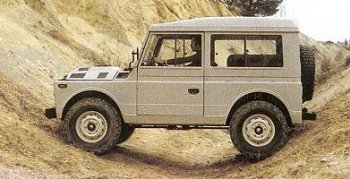
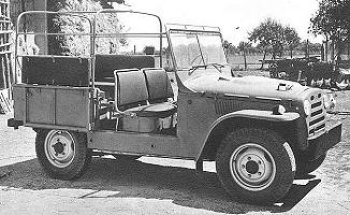
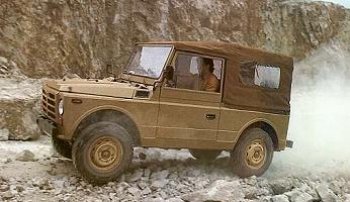 |
|
The new vehicle is expected to be called the Fiat
Campagnola when it reaches the market, reviving a
near-legendary name which adorned a much-loved
Fiat-built jeep (above) for three and a half
decades, in two versions. |
|
|

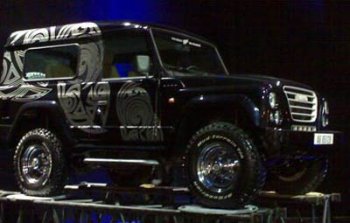 |
|
The Massif is the fruit of a new industrial
collaboration between Fiat Group-owned Iveco and
Spanish off-road vehicle manufacturer Santana Motor. |
|
 |
|
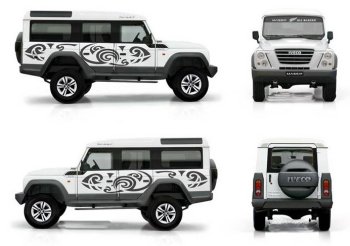 |
|
The Iveco Massif
is closely based on the Santana PS-10 Anibal 4x4
which was introduced to the markets four years ago.
The PS-10 was in turn a new development of the
long-running 2500 series which chases its lineage
back to the Land Rover Defender. |
|
 |
|
 |
|
Iveco are initially targeting annual sales volumes
of 5,000-6,000 Massif vehicles, with the focus being
on professional use, widening their niche portfolio. |
|
|
Detail improvements to the
car were also introduced such as a demister for the windscreen and a
change to the lighting. The military version became the AR55, with a
lower power version of the new engine, with 56bhp. The range received minor
detail again in 1959, with no change in definition except for the
military version which became the AR59. Then in 1960 the Campagnola B arrived. This was an improved diesel version
(the Campagnola A continued as the petrol with no change) with a revised
engine producing 47bhp and a variety of other minor changes. The final
diesel version was the Campagnola C. Introduced in 1968 this had an
engine with a displacement of 1895cc and a power output of 47bhp. Total production of the Campagnola until 1973 was 7,783 diesel engined examples, and 31,293 petrol engined ones.
In 1974 the all new Campagnola was released, launched in a rather
low-key way at the Belgrade Motorshow of that year. This used a 1995cc
engine derived from that in the 1.8-litre 132, modified to increase its
capacity and to have a single cam in the block. The resulting engine
produced 80bhp and drove through a similar layout to the old car, four
speed transmission, permanent rear wheel drive, selectable front wheel
drive, and a reduction box. Independent suspension for all four wheels (with torsion bars front
and rear) and a load-bearing bodyshell were used. Unusually a double
front passenger seat, combined with the driver and four in the rear,
provided seating for seven. Numerous typical off-road extras were
standard or optional, such as locking differentials on both axles,
adjustable lights, various tyre sizes, etc. Given the low production volumes of the car, assembly was by
Pininfarina at the Grugliasco factory.
In 1976 three additional variants joined the range. The standard
length car became available with a hard top as well as the original
canvas roof, and a version with a stretched bodywork (an extended rear
overhang allowed for three seats on each bench, giving a total seating
capacity of nine people) was introduced, both with a soft and a rigid
roof. The roof in both long and short versions was a metal affair, with
side windows, fixed to the body by bolts, and hence removable. The military version of the Nuova Campagnola emerged in 1976, hence
known as the AR76, and featured numerous options designed to optimise
its capability off-road. It also featured a slightly less powerful
engine with 75bhp.
1979 saw the nuova Campagnola receive diesel engines, a 2-litre
(with 60bhp) and a 2.5-litre (with 72bhp), both made by Sofim. At the
same time all the models (including the petrol engined variants)
received a five speed gearbox, the limited slip differential became
standard at the rear (previously an option, it remained optional for the
front axle) and a variety of other minor improvements. The military
version became the AR76A. Production in Italy continued until 1985, although odd vehicles
emerged from the plant until 1987. The Campagnola was also assembled in Yugoslavia by Zastava in the
early 1950's. All the parts were sent from Turin by train, with only
final assembly carried out locally. These vehicles were also exported,
getting as far as India.
|
|
|
|